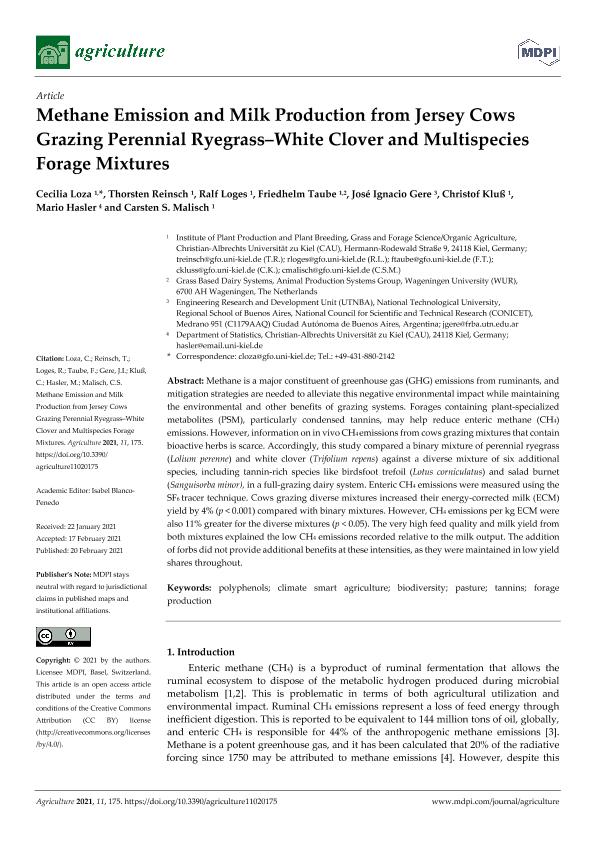Artículo
Methane emission and milk production from jersey cows grazing perennial ryegrass–white clover and multispecies forage mixtures
Loza, Cecilia; Reinsch, Thorsten; Loges, Ralf; Taube, Friedhelm; Gere, José Ignacio ; Kluß, Christof; Hasler, Mario; Malisch, Carsten S.
; Kluß, Christof; Hasler, Mario; Malisch, Carsten S.
 ; Kluß, Christof; Hasler, Mario; Malisch, Carsten S.
; Kluß, Christof; Hasler, Mario; Malisch, Carsten S.
Fecha de publicación:
02/2021
Editorial:
MDPI AG
Revista:
Agriculture
ISSN:
2077-0472
Idioma:
Inglés
Tipo de recurso:
Artículo publicado
Clasificación temática:
Resumen
Methane is a major constituent of greenhouse gas (GHG) emissions from ruminants, and mitigation strategies are needed to alleviate this negative environmental impact while maintaining the environmental and other benefits of grazing systems. Forages containing plant-specialized metabolites (PSM), particularly condensed tannins, may help reduce enteric methane (CH4) emissions. However, information on in vivo CH4 emissions from cows grazing mixtures that contain bioactive herbs is scarce. Accordingly, this study compared a binary mixture of perennial ryegrass (Lolium perenne) and white clover (Trifolium repens) against a diverse mixture of six additional species, including tannin-rich species like birdsfoot trefoil (Lotus corniculatus) and salad burnet (Sanguisorba minor), in a full-grazing dairy system. Enteric CH4 emissions were measured using the SF6 tracer technique. Cows grazing diverse mixtures increased their energy-corrected milk (ECM) yield by 4% (p < 0.001) compared with binary mixtures. However, CH4 emissions per kg ECM were also 11% greater for the diverse mixtures (p < 0.05). The very high feed quality and milk yield from both mixtures explained the low CH4 emissions recorded relative to the milk output. The addition of forbs did not provide additional benefits at these intensities, as they were maintained in low yield shares throughout.
Archivos asociados
Licencia
Identificadores
Colecciones
Articulos(SEDE CENTRAL)
Articulos de SEDE CENTRAL
Articulos de SEDE CENTRAL
Citación
Loza, Cecilia; Reinsch, Thorsten; Loges, Ralf; Taube, Friedhelm; Gere, José Ignacio; et al.; Methane emission and milk production from jersey cows grazing perennial ryegrass–white clover and multispecies forage mixtures; MDPI AG; Agriculture; 11; 2; 2-2021; 1-17
Compartir
Altmétricas



